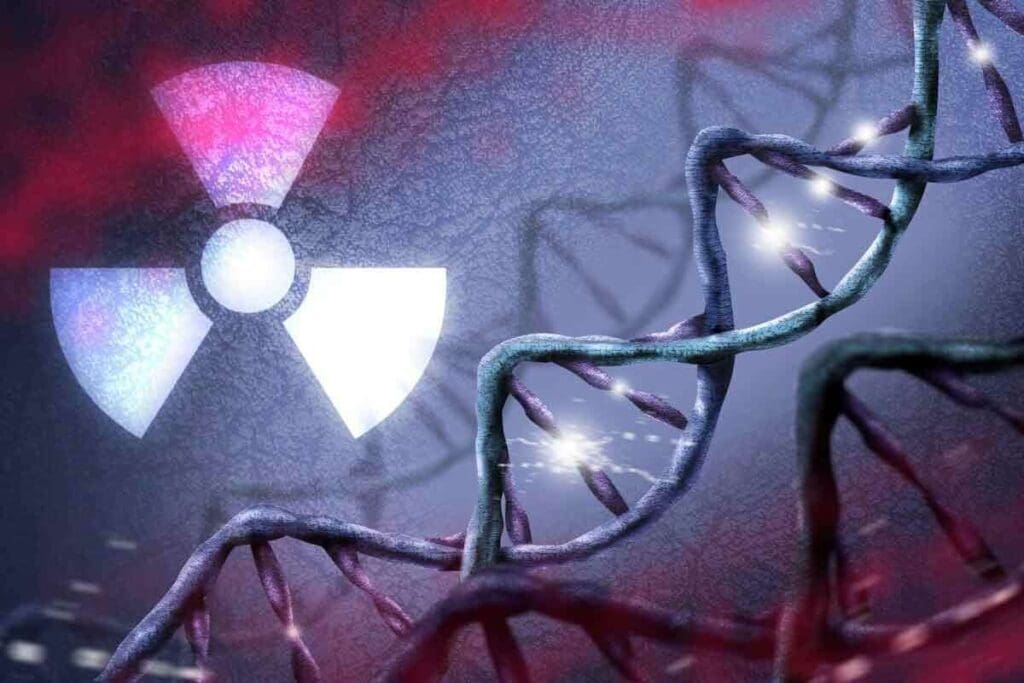Last Updated on November 27, 2025 by Bilal Hasdemir

At Liv Hospital, we focus on radiation safety to protect our patients. Ionizing radiation can change atoms or molecules, and knowing about the different types of radiation, including which is the most harmful radiation, is key to understanding their dangers.
.
We’ll look at alpha, beta, and gamma radiation to find out which is most dangerous. By studying their properties, we can grasp their risks to living things and how far they can travel.
Key Takeaways
- Ionizing radiation includes subatomic particles or electromagnetic waves that can ionize atoms or molecules.
- Alpha, beta, and gamma radiation vary in penetration power and biological risk.
- Understanding the characteristics of each radiation type is critical in assessing their harm.
- Liv Hospital prioritizes radiation safety to ensure patient well-being.
- Advanced medical treatments are used at Liv Hospital to reduce radiation risks.
Understanding Radiation Types and Their Basic Properties

Radiation comes in many forms, each with its own dangers. To understand the risks of radiation, we need to know the different types and their effects.
What Is Ionizing Radiation?
Ionizing radiation is energy that can remove electrons from atoms. This can damage DNA in cells, leading to health problems like cancer. We get exposed to it from cosmic rays and radioactive materials.
Ionizing radiation includes alpha, beta, and gamma radiation. Each type affects tissues and causes damage differently.
The Three Primary Types of Radiation
Alpha Radiation: Alpha particles are high-energy helium nuclei. They have a strong ionizing capacity but a short range. A sheet of paper or human skin can stop them. But, they can harm if inhaled or ingested.
Beta Radiation: Beta particles are high-energy electrons. They are smaller than alpha particles and can penetrate deeper. But, a thin layer of metal or a few meters of air can stop them.
Gamma Radiation: Gamma rays are high-energy electromagnetic waves. They can penetrate deeply into tissues and materials. Thick, dense materials like lead are needed to stop them.
How Radiation Is Measured and Quantified
Radiation exposure is measured in several ways. The absorbed dose measures energy deposited in tissue. The unit is the Gray (Gy). Another measure is the Sievert (Sv), which considers the biological effect of radiation.
Understanding these units is key to assessing radiation risks. The types of radioactivity affect us differently based on their type and energy.
Alpha Radiation: The Heavy Hitter

Alpha particles are known as the heavy hitters in radiation. They have a lot of mass and charge. These high-energy helium nuclei are released during certain radioactive decay processes.
Physical Characteristics of Alpha Particles
Alpha particles are big and carry a double positive charge. This makes them very good at taking away electrons from atoms. They can do a lot of damage to living tissues.
Penetration Capabilities and Limitations
Alpha particles can’t travel far. A sheet of paper or the outer layer of dead skin can stop them. But, they’re not safe just because they can’t go far.
Sources of Alpha Radiation in Daily Life
Alpha radiation comes from some natural and man-made materials. You can find it in radon gas in homes, smoke detectors, and some industrial materials.
Why Alpha Radiation Is Dangerous When Internalized
If alpha-emitting materials get inside the body, they can be very harmful. Alpha particles can only go a short distance in tissue. They release all their energy in one spot, causing a lot of damage to nearby cells.
| Characteristics | Alpha Radiation |
| Composition | High-energy helium nuclei |
| Charge | Double positive charge |
| Penetration | Stopped by skin or paper |
| Danger | Highly ionizing, dangerous when internalized |
Beta Radiation: The Middle Ground
Beta radiation is made up of high-energy electrons. It falls between alpha and gamma radiation in terms of how far it can go and how much damage it can do. We will look into its features, where it comes from, and how it might affect our health.
Physical Properties of Beta Particles
Beta particles are high-energy electrons that some radioactive nuclei send out. They are smaller than alpha particles and have a negative charge. Because of their size and energy, beta particles can travel quite far in air and a bit into tissue.
Key characteristics of beta particles include:
- High energy electrons or positrons
- Smaller than alpha particles
- Negative charge
- Can travel several meters in air
- Can penetrate a few millimeters of tissue
Penetration Power and Skin Damage
Beta radiation can go through more than alpha radiation but doesn’t ionize as much. It can burn the skin and damage the skin’s surface. But, it’s not as strong as gamma radiation and can be stopped by a little metal or a lot of air.
Common Sources of Beta Radiation
Beta radiation comes from many radioactive materials in nature and made artificially. Some common sources are:
- Radioactive isotopes used in medical treatments
- Nuclear reactors and nuclear waste
- Certain industrial applications
- Fallout from nuclear explosions
Is Beta Radiation Harmful to Internal Organs?
Yes, beta radiation can harm internal organs if swallowed or breathed in. The damage depends on the beta particle’s energy and how long you’re exposed.
| Exposure Route | Health Risk |
| External Exposure | Skin burns, radiation dermatitis |
| Internal Exposure (Ingestion/Inhalation) | Damage to internal organs, possible radiation sickness |
It’s important to know the risks of beta radiation to create good safety measures. We need to think about both outside and inside exposure to protect ourselves.
Gamma Radiation: The Penetrating Force
Gamma rays are known for their ability to penetrate deeply. They are a type of electromagnetic radiation, like X-rays, but with more energy. This lets them go through materials that alpha and beta particles can’t.
Physical Nature of Gamma Rays
Gamma rays come from an atom’s nucleus during radioactive decay or nuclear reactions. They have no mass or charge, unlike alpha and beta particles. This lets them travel far through air and go through many materials.
“Gamma radiation is a highly penetrating form of ionizing radiation,” experts say. “It can go through the human body, which is both useful in medicine and dangerous if not handled right.”
Exceptional Penetration Abilities Through Materials
Gamma radiation’s main feature is its ability to penetrate deeply. It can go through several centimeters of lead or meters of concrete. This makes gamma rays useful for sterilizing medical tools and food irradiation. But, it also means we need strong shielding to protect against it.
- Gamma rays can penetrate the human body, causing damage to deep tissues and organs.
- Dense materials like lead are required to effectively shield against gamma radiation.
- The high penetration power of gamma rays makes them suitable for various industrial and medical applications.
Where Gamma Radiation Is Found
Gamma radiation comes from natural and man-made sources. It’s found in the earth’s crust and in cosmic radiation from space. Man-made sources include nuclear reactors, medical equipment, and some industrial uses.
Deep Tissue and Organ Damage from Gamma Exposure
Gamma radiation’s high penetration can harm internal organs and deep tissues. Exposure can cause radiation sickness, with symptoms like nausea, fatigue, and damage to the bone marrow, lungs, and gut. The harm depends on the dose and how long you’re exposed.
Protecting against gamma radiation needs careful planning and the right shielding materials. Knowing where gamma radiation comes from and its effects is key to reducing risks in places like hospitals and factories.
Biological Effects of Radiation Exposure
Radiation exposure is harmful to human health. It affects cells and DNA. Ionizing radiation can damage molecules, leading to cell death or mutations.
How Radiation Damages Cells and DNA
Ionizing radiation has enough energy to remove tightly bound electrons from atoms. This creates ions and damages cellular components, like DNA. DNA damage can happen directly or through free radicals.
If not fixed, DNA damage can cause mutations and instability in the genome.
Key mechanisms of radiation-induced DNA damage include:
- Single-strand breaks
- Double-strand breaks
- Base damage
- Cross-linking between DNA strands or between DNA and proteins
Acute vs. Chronic Radiation Exposure
The health effects of radiation exposure differ between acute and chronic exposure. Acute exposure means a high dose in a short time. Chronic exposure is lower doses over a long time.
| Exposure Type | Dose Rate | Health Effects |
| Acute | High dose in a short time | Immediate damage, radiation sickness, possible death |
| Chronic | Low dose over a long time | Increased risk of cancer, genetic mutations |
Radiation Dose Measurements and Health Impacts
Radiation doses are measured in sieverts (Sv). Different doses have different health effects. Knowing these measurements helps understand radiation risks.
The health impacts of radiation depend on the dose. High doses can cause immediate harm, like radiation sickness and death. Lower doses may raise cancer and genetic mutation risks over time.
The Most Harmful Radiation Type: Contextual Analysis
Finding the most harmful radiation type is tricky. It depends on many factors, like how you’re exposed. It’s key to know the difference between being exposed from outside and inside.
External Exposure Dangers: Why Gamma Often Poses Greatest Risk
Gamma radiation is very dangerous when you’re exposed from outside. It can go deep into your body. This is bad news for your organs and tissues.
In nuclear accidents or some medical treatments, gamma radiation is a big risk. It’s hard to stop gamma rays from spreading in places like hospitals or factories.
Internal Exposure: Alpha’s Concentrated Damage
But alpha radiation is a big worry when it’s inside you. Alpha particles are big and pack a punch. They can’t get through your skin but can hurt a lot once inside.
Alpha radiation is really bad if you swallow it or breathe it in. It can focus its damage in one spot, like your lungs or liver. This can lead to serious health problems, like cancer.
Comparing Lethality in Different Exposure Scenarios
Alpha, beta, and gamma radiation have different dangers based on how you’re exposed. Gamma is more dangerous from the outside because it can go deep. But alpha is more risky if it’s inside you.
Knowing these differences helps us protect better against radiation. By understanding the risks of each type and how they affect us, we can keep people safer from radiation harm.
Protective Measures Against Different Radiation Types
To keep safe from radiation, we need the right protection. It’s key in places where alpha, beta, or gamma radiation is present.
Shielding Materials and Their Effectiveness by Radiation Type
Shielding is a main way to protect against radiation. Each type of radiation needs a specific material to block it, based on how far it can go.
Alpha particles are stopped by a paper sheet or human skin. But, if these particles get inside us, they can harm a lot.
Beta particles need thicker shielding. Aluminum or plastic can block them. The thickness needed depends on the beta’s energy.
Gamma rays are the most penetrating. They need dense materials like lead or thick concrete to block. The material’s thickness and density matter a lot.
Distance and Time as Protection Factors
Distance and time are also key in protecting against radiation. Radiation weakens with distance, making it a strong shield.
Shortening exposure time is also important. The longer you’re exposed, the more radiation you get. Changing who’s in the area and limiting their time can reduce exposure.
“The key to radiation safety is minimizing exposure through a combination of shielding, distance, and time.”
Personal Protective Equipment for Radiation Safety
Personal protective equipment (PPE) is essential for safety. It includes gloves, masks, and coveralls to prevent skin contact and ingestion of radioactive stuff.
In places with radiation risks, wearing PPE is a must. It helps prevent external contamination and reduces the chance of internal exposure through breathing or eating.
Using shielding, keeping distance, managing time, and wearing PPE helps lower radiation exposure. This makes a safer place for those around radioactive materials.
Real-World Radiation Incidents and Their Health Consequences
Historical radiation accidents teach us a lot about the dangers of ionizing radiation. It’s key to learn from these events to protect our health.
Notable Radiation Accidents and Disasters
Many radiation incidents have harmed people and the environment. The Chernobyl disaster in 1986 is a major example. It released a lot of radioactive material into the air.
Another example is nuclear weapon tests around the world. These tests have spread radioactive pollution far and wide.
Looking into these incidents helps us understand their causes and effects. For example, Chernobyl’s health impacts are well-studied. It shows how radiation can lead to thyroid cancer and other health problems.
Lessons Learned from Historical Exposure Cases
Studying past radiation exposure cases teaches us a lot. For instance, the atomic bombings in Hiroshima and Nagasaki have helped us understand radiation’s effects on health.
| Incident | Year | Health Consequences |
| Chernobyl Disaster | 1986 | Increased thyroid cancer, other health issues |
| Hiroshima and Nagasaki Atomic Bombings | 1945 | Radiation sickness, long-term cancer risks |
| Nuclear Weapon Tests | Various | Widespread radioactive contamination, health impacts |
By studying real-world radiation incidents, we can grasp the risks of radiation better. For more on alpha, beta, and gamma radiation, check out our blog post.
Conclusion: Which Radiation Truly Poses the Greatest Danger?
Finding the most dangerous radiation type is complex. It depends a lot on how you’re exposed to it. We’ve looked at alpha, beta, and gamma radiation. Each has its own special traits and health risks.
Gamma radiation is seen as the most harmful because it can travel far. This makes it a big risk if you’re exposed to it outside. But, if radiation gets inside you, alpha particles are more dangerous. They pack a big punch and can harm tissues close to them.
The health effects of radiation depend on the type, how much you’re exposed to, and how well you’re protected. Knowing these things helps us reduce the risks of radiation.
In short, the most dangerous radiation type changes based on the situation. Gamma radiation is a big threat outside, but alpha radiation is more dangerous inside. By understanding these differences, we can keep ourselves and others safer from radiation dangers.
FAQ
What is the most dangerous type of radiation?
The danger of radiation types varies based on how you’re exposed. Gamma radiation is very harmful because it can go through a lot of material. But alpha radiation is worse if you eat or breathe it in because it can damage your insides.
Is beta radiation harmful?
Yes, beta radiation can harm you, mainly if you swallow or breathe it in. It can hurt your internal organs. It can also burn your skin.
Can alpha particles penetrate skin?
No, alpha particles can’t get through your skin. But if you eat or breathe them in, they can really hurt your insides.
Which radiation type is the most penetrating?
Gamma radiation is the most penetrating. It can go through your body and hurt deep tissues and organs.
What are the sources of alpha, beta, and gamma radiation?
Alpha radiation comes from certain radioactive decay. Beta radiation is from some radioactive nuclei. Gamma radiation is from nuclear reactions and decay.
How can radiation exposure be minimized?
To reduce radiation exposure, use shielding materials and stay far from the source. Limit your time near it. Wearing protective gear is also key to staying safe.
What are the health impacts of radiation exposure?
Radiation can damage cells and DNA, leading to health issues. The effects depend on the dose, type of radiation, and how you’re exposed.
What is the difference between acute and chronic radiation exposure?
Acute exposure means getting a lot of radiation quickly. Chronic exposure is getting a little radiation over a long time. Both can harm your health.
How is radiation measured and quantified?
We measure radiation with units like sieverts (Sv) and grays (Gy). These units consider how different types of radiation affect living things.
Reference
- LibreTexts Chemistry: Types of Radioactivity—Alpha, Beta, and Gamma Decayhttps://chem.libretexts.org/Bookshelves/Introductory_Chemistry/Introductory_Chemistry_(LibreTexts)/17:_Radioactivity_and_Nuclear_Chemistry/17.03:_Types_of_Radioactivity-_Alpha_Beta_and_Gamma_Decay






